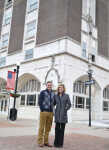Western Insurance building owner explains plans

The Western Building was once a vital part of downtown Fort Scott and will be again by the end of 2016, according to Tony Krsnich during a press conference Monday morning.
Krsnich is the CEO for Flint Hills Holdings, the development company that has been working with the City of Fort Scott for 1.5 years on plans to rehabilitate the Western Building into apartments for persons 55 years and older.
"Construction will start this month within the historic (Western) building." Krsnich said. "Hopefully there will be a ribbon cutting event in late fall 2016."
The apartments will be located in the three-story building that has been vacant for about 30 years.
"For a long time, Western Insurance employees shopped, ate at the restaurants and helped downtown thrive," Lindsay Madison, executive director of Fort Scott Area Chamber of Commerce, said. "We are looking forward to the development of living downtown."
"We were dealt with the task of how to incorporate a historic building, a 55,000-square-foot Western Insurance building and the non-historic building to the west," Krsnich said.
They decided to demolish the non-historic building.
"The 55,000-square-feet building will be incorporated into 35 luxury, affordable units for seniors," Krsnich said.
There will be 24 one bedroom apartments, approximately 600-to-650-square-feet, and 11 two-bedroom apartments with 800-square-feet, Krsnich said.
"The investment we are going to make on the project is over $5 million dollars," Krsnich said. "We finally gave the notice to proceed last Wednesday."
"The reason why we chose to pursue the project was because, based on product we are going to provide, similar projects here in town were doing very well," Krsnich said.
"We are extremely excited not only to have people building a restored historic building downtown that has been blighted for a number of years," Madison said. "But to have the residential apartments downtown and to have activity to help our other businesses downtown thrive more than they do already."
There are senior living residences available in Fort Scott, but this will add to the choice residents have, Madison said.
Madison projects give people an incentive to move to Fort Scott from other areas to experience the quality of life offered here or because of family ties to the area.
Good for the city
"We do a good job using local contractors as far as possible," Krsnich said. "Jobs are going to be retained, jobs are going to be created. I'm very interested in taking a look at what happens to the other dark store fronts on Main Street as a result of this project. I'm interested in looking at future development here in Fort Scott."
Small towns everywhere have seen the declines in vibrancy, he said
"By no means do I think all of them can be stabilized or experience growth as they did in the good old days," Krsnich said. "But county seats like Fort Scott, especially where there is a community college presence, not to mention a national (park) here, create very unique opportunities, not to mention the proximity to Kansas City. It takes about an hour and 15 minutes to get down here."
"There is no silver bullet to address downtowns in small towns in rural America," Fort Scott Economic Director Heather Smith said. "This project will not fix our downtown, but what it will do is bring opportunity for additional development. We have people we are talking to for potential businesses once these residences are built."
The project sets a good example of what can be done to take advantage of available tax credits to revitalize some of these historic structures, Smith said.
Partnerships
The project wouldn't have been possible without the help of the City of Fort Scott, Krsnich said.
"Heather (Smith) has been the key player in this project, she and Tony have worked hand in hand over the few years," Madison said.
The city provided just under $1 million to abate the building as well as demolish the non-historic building, Krsnich said.
Smith said it has been a long process, with "a lot of approvals that had to happen. We worked with the Department of Health and Environment and were able to get Brownfields Grant funding to have some analysis done. We discovered that there was over a million dollars in concerns that had to be remediated. In reaching out to developers, one of the main things was this was not something they would take on with the environmental conditions....If we continue(d) to let it deteriorate, pretty soon we will be needing to demolish the structure. It has so much historic significance to Fort Scott.
"With (Tony's) relationships we were able to squeeze the number for remediation and demolition of the non-historic down to under $1 million. At that point we had some funds in our capital improvement sales tax funds. In discussing with our (city) commissioners, if we commit this money now, that Tony would follow through and develop the building into apartments."
"They are forward thinking in that regard," Krsnich said. "It wouldn't have been a feasible project from a financial standpoint."
Tax abatement
Krsnich said without the availability of a tax abatement, his company could not have afforded the entire $5-$6 million.
